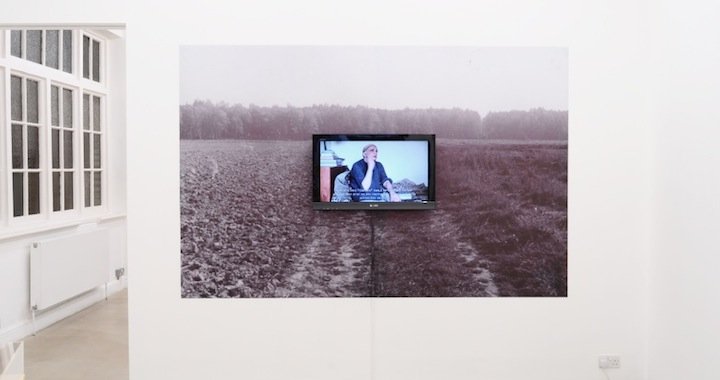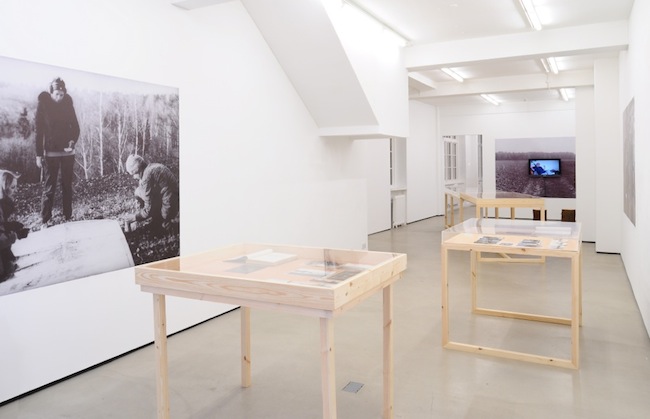
Exhibition of Books: Collective Actions Group
Juste Kostikovaite
13/08/2012
Regina gallery is one of the few galleries working and representing Russian artists in London. Arterritory.com recently published an interview with the Regina gallery founder Vladimir Ovcharenko. In this interview he was not asked much about the potentialities of certain art-practices of the artists that his gallery currently represents, but rather more in-depth questions about his intuition and feelings on what “will sell well and what won't”. Having said hat, this June, Regina gallery in London made a very interesting move by organising an exhibition devoted to the extraordinary archival material on the documentation of conceptual art actions – “Trips out of Town” (“Poezdki za Gorod”). It’s on view through August 18th.
The exhibition consists of books, photographs, slides and a video interview. It is the first time that this material is being shown in London, and also the first solo exhibition for Collective Actions Group in the United Kingdom.
A series of books (most of them written on old typewriters) have been compiled by the artist and art theoretician Andrei Monastyrski for the Collective Actions Group. The exhibition covers selected material from the first seven volumes (1976–1997) of this on-going book and action project. The exhibition also presents a slide-show, put together from select photographs documenting the actions. A video interview, done several days before the opening,is also on view. Maybe it served to compensate for the fact that the artist was not present during the opening. In any case, the interview helped to understand the current opinion of Monastyrski about life in Moscow in the context of the 70’s – almost 40 years ago – which is when the Collective Actions Group began their actions.

Founded in 1976, the Collective Actions Group has produced over 125 actions up to the present day. An action is an orchestrated event to which a small group of people are invited. Usually they are friends and other artists; in the case of Monastyrski, they were other poets, translators, writers and painters. During Soviet times, which is when the actions took place, one can assume that only very close friends were invited, so that the actions could form a closed membership, or, in a way, some secret society. Those invited usually had to be not only highly trustworthy, but also open and completely flexible. Sometimes the invitation to participate in the action came in the evening, and early the next morning, the invited guests had to change their plans and take a train or a trolleybus and head to the unknown action. Those invited were often required to have a particular interest in the actions, since most people usually have some obligations, such as friends' birthdays and family issues.

As Monastyrski explains in his interview, his background is in literature and music. Andrei Monastyrski was a poet, gradually easing into contemporary poetry. He was also interested in music. The most important figure at those times for Monastyrski was John Cage, whose influence one can trace in the many actions where there were structures in which the lines of sound and visual perception could intersect.
Books are the genesis of literature, and for Monastyrski it was natural to think about books when the actions started in 1976. All actions needed to be documented, otherwise, according to Monastyrski, they would disappear. Even more important for the Collective Actions Group is not the threat of disappearance of the activity or event, but to be able to understand where and how the event lives through the construction of new events and according to previous experiences, by tracing and expanding the boundaries of the “fact”. Here, documentation of the action served as the main strategic component of the actions themselves; it was the core of the building of the conceptual structure of the actions. All further actions of the Collective Actions Group were conceived by reflecting and analyzing previous actions. This reflection could be done only if those actions were captured in documents, essays, comments, and descriptions. Moreover, it allowed the actions to reveal themselves in continuum; for example, the action titled “The Appearance”, from the First Volume Book, is sometimes referred to in the Second and Third Volumes. In this way, the authors reformulate the meaning of the action by reflecting on it and, at the same time, modifying and continuing it. In that sense, all actions of the Collective Actions group can be viewed as one gigantic action, one volume, one big narrative.

The books were constructed by building four informational levels. The first level was the discourse, which was put into the preface. It is important to note that Monastyrski himself always wrote in all of the volumes, causing his voice to sound very strong and authoritative – a voice that the reader can trust – but at the same time, a voice which can change the previously narrated discourse and story in retrospect. In the preface of the book, Monastyrski tries to to talk about theory, to analyse philosophical-aesthetical questions and trends, and speaks around the structures of language, space and time. The second level of the book is the factual description of the actions. The language of these descriptions is extremely precise, almost mathematical; it also contains meticulous drawings and minimalist-style schemes, exact coordinates and the topography of the action, places and movement lines of the objects and people who have participated in the action and, of course, the date, time and list of participants. The third level is the narrative of the action. The narrative is the collection of reflections (in the form of essays) of the viewers-participants (as Monastyrski called the participants of the actions). Through the reflections, participants shared their thoughts about the actions – how they were experiencing the action themselves, what they felt, what they saw, and how their perception changed before, during and after the action. The fourth level is “factography”, which consists of invitations, other documents of the actions and, obviously, photographs.
Of course, actions exist now only in books, as there are no actions, because they are constantly continuing. But books are also more than actions in that they expand the definition of documentation; and as books, they bear the mark of time. They are in themselves an object – the object of art, the microcosm, the world.
22 Eastcastle Street
London, United Kingdom
www.reginagallery.com/